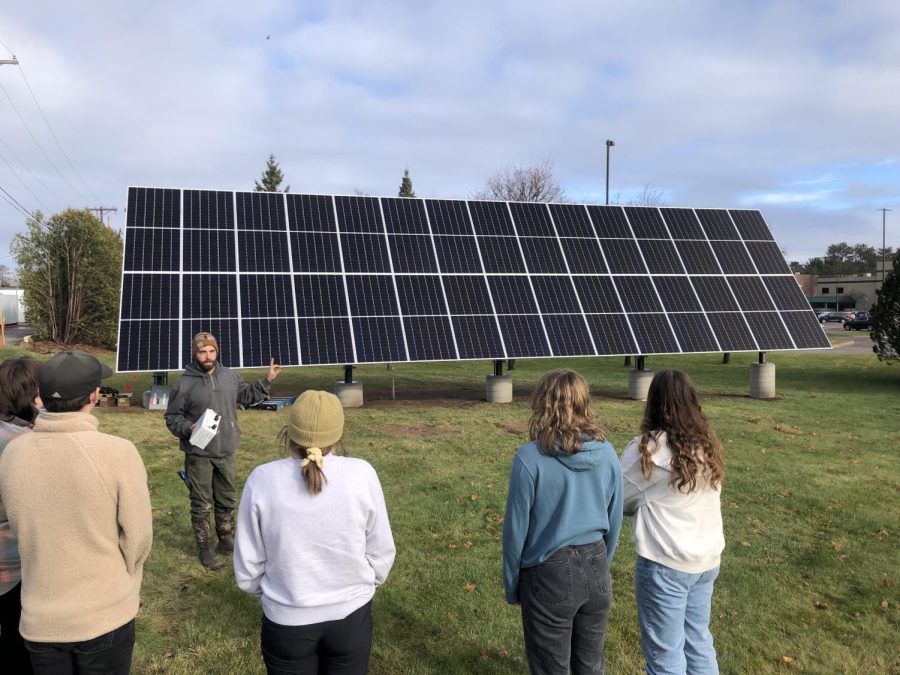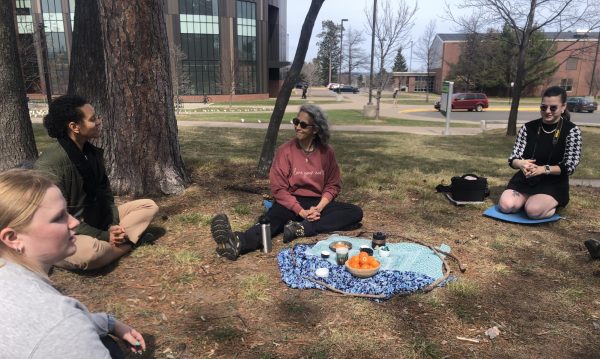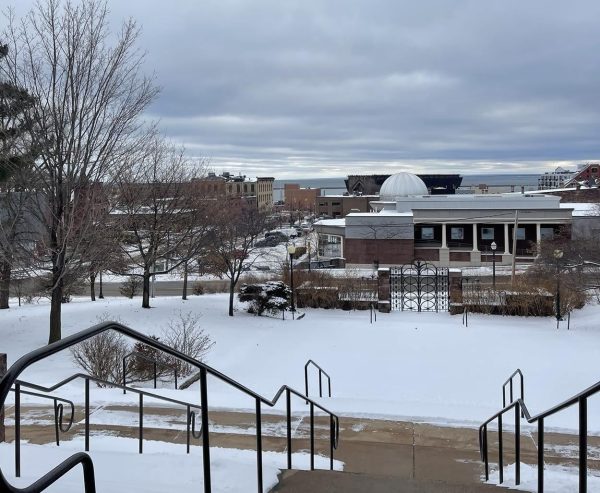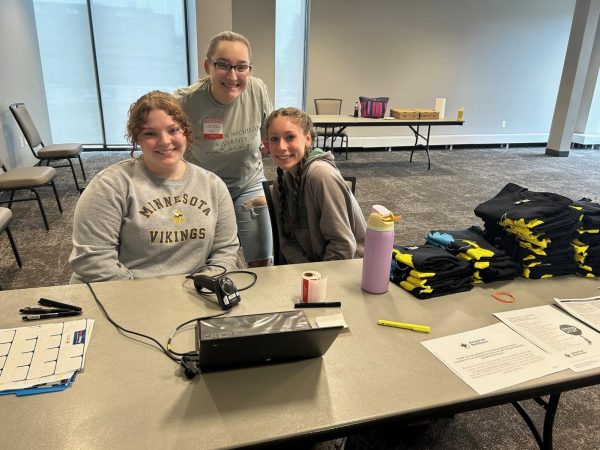Campus solar panels funded entirely by NMU students
Photo courtesy of Jessica Thompson
SUN POWER — NMU students listen as a member of the solar panel installation crew explains how the bifacial panels work. The fully operational panels, located next to the SHINE building on Presque Isle Avenue, are the largest project to be financed entirely by the Green Fund, a five-dollar per semester student-paid fee.
January 30, 2023
Thanks to the student-paid Green Fund, a $50,000 solar panel array has been installed next to the Sustainability Hub for Innovation and Environment (SHINE) building, located at 1400 Presque Isle Ave.
The solar panels have been fully operational and collecting energy from the sun since November 2022, less than a year after their original proposal. The bifacial panels, which absorb direct, diffuse and albedo forms of light from both sides, are being used to power most of the SHINE office free of charge.
Jessica Thompson, professor at the College of Business and director of SHINE, said the solar array project was the most innovative proposal EcoReps, the student organization overseeing the Green Fund, has ever received.
“This is what the [Green Fund] is for,” Thompson said. “This is what people are asking for all the time, so we were pumped.”
In November 2021, an NMU student suggested monies collected by the Green Fund be put toward a $25,000 demonstration solar array to show people that energy from the sun can be collected and reused. After both EcoReps and the Sustainability Advisory Council reviewed and rated all of the student-submitted proposals, the solar array became their top priority.
The project was transferred to NMU Facilities, which conducted the bidding process with companies interested in the installation process. After being told that a $25,000 array was barely enough to generate the energy to power the building, however, NMU Facilities proposed an even grander idea to the involved parties.
“Facilities came back to the Sustainability Advisory Council, which includes EcoReps … and said, ‘what if we doubled it?’” Thompson said. “The Green Fund at that time had over $70,000 in it, so we were like, ‘let’s do it.’”
The President’s Council ultimately approved the project and the bid to install the array went to Peninsula Solar, a company located in northern Michigan owned by an NMU alumnus.
The original solar proposal did not declare where exactly the array was to be located. However, after Invent@NMU relocated downtown, the office building next to Temaki and Tea was offered to SHINE. Considering the space had optimal sun exposure and would be an easy hook-up for installers, the building seemed the perfect spot for a sustainability learning hub on campus.
“Those solar panels are the big sign, almost like a billboard, that says NMU is making some moves with sustainability,” Thompson said.
The history of the Green Fund at NMU begins in 2016 when a small group of students collaborated to create an “Invest in Innovation” initiative. The students later presented the Green Fund to the ASNMU executive board, and their proposal ended up on the 2018 ASNMU ballot. After 76% of voting students approved of the initiative, the Green Fund was presented to the NMU Board of Trustees, where it received overwhelming support.
As a result of this support, EcoReps was to be created and required to demonstrate success in its sustainability efforts. After achieving this and fine-tuning the logistics of implementing an ongoing student fee, the Green Fund was once again proposed to students in a campus-wide survey. Every student that voted did so in favor of the Green Fund, and the NMU Board of Trustees later approved the initiative in the summer months of 2020.
Freshman and EcoReps intern Grace Listopad, who is studying sustainable business and enterprise creation, said the Green Fund is a tool students can use to have their voices heard regarding sustainability on campus.
“Solar panels seem like such a big project … and it is honestly super duper cool that we are able to do this and have students make a difference in the sustainability of campus,” Listopad said. “The solar panels are a great way to show that the Green Fund is doing things and that if you have an idea, share it with us.”
Since it has been active, the Green Fund has collected over $120,000 from students. These funds have been used for several projects in the past, including the clover lawn that currently rests near the West Hall demolition site. Now with the solar panel installation, Listopad said the future of sustainability on NMU’s campus is bright because of the Green Fund.
Students can expect to see the expansion of no-mow zones, the implementation of infrastructure for clothing donation and more recycling opportunities in the future as a result of the Green Fund. These proposals are currently waiting for approval from the President’s Council.
If students would like to see more solar on campus, Thompson said the new integrated Health and Wellness Center is constructed to accommodate solar installation on its roof. Because the Green Fund is powered by student-generated initiatives, an NMU student must propose this idea to EcoReps and the Sustainability Advisory Council for it to become a reality.
“If there are students out there that want to make a difference, the Green Fund is a great opportunity to do so,” Listopad said. “Even if you just have an idea … we will work with you to make this project a reality if we think it is feasible on NMU’s campus because sustainability is our number one goal here.”

































